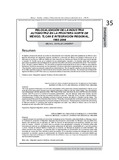| dc.rights.license | http://creativecommons.org/licenses/by-nc-sa/3.0/ve/ | |
| dc.contributor.author | Selva L., Daville Landero | |
| dc.date.accessioned | 2016-02-02T10:50:25Z | |
| dc.date.available | 2016-02-02T10:50:25Z | |
| dc.date.issued | 2016-02-02T10:50:25Z | |
| dc.identifier.issn | 1316-6727 | |
| dc.identifier.uri | http://www.saber.ula.ve/handle/123456789/41518 | |
| dc.description.abstract | El objetivo principal del artículo es mostrar la relocalización de la industria automotriz establecida en México como
ejemplo del proceso de integración regional, económica y comercial, de México con Estados Unidos que se vio
reforzado con la rma en 1994 del Tratado de Libre Comercio con América del Norte (TLCAN) que incluye también
a Canadá. El TLCAN ocurre en el contexto de una globalización creciente y la industria automotriz mexicana
permanece supeditada a las estrategias de las grandes compañías armadoras, principalmente de las “Tres Grandes”
(Ford, Chrysler y General Motors). Por otra parte se presenta la relocalización de la rama en México hacia Estados
fronterizos. El artículo se compone de tres apartados. El primero describe la regionalización y concentración de las
“Tres Grandes” sobre la producción automotriz mundial desde los 70s; El segundo analiza los cambios de la misma.
En el último apartado expone la restructuración de la industria automotriz mexicana. Se concluye que la integración
regional de México al NAFTA ha sido muy complicada debido al desarrollo y tamaño de las economías involucradas. | es_VE |
| dc.language.iso | es | es_VE |
| dc.rights | info:eu-repo/semantics/openAccess | |
| dc.subject | Integración regional | es_VE |
| dc.subject | Fronteras | es_VE |
| dc.subject | Industria automotriz | es_VE |
| dc.title | Relocalización de la industria automotriz en la frontera norte de México, TLCAN e integración regional, 1993-2008 | es_VE |
| dc.title.alternative | Relocation of the automotive industry to Mexico’s northern border states, NAFTA and regional integration, 1993-2008 | es_VE |
| dc.title.alternative | Implantation de l’industrie automobile à la frontière nord du Mexique, l’alena et l’intégration régionale, 1993-2008 | es_VE |
| dc.type | info:eu-repo/semantics/article | |
| dc.description.abstract1 | The main purpose of the essay is to show the relocalization of the automotive industry established in Mexico as an
example of the commercial, economic and regional integration of Mexico with the United States. The relocalization
was strengthened with the signature of the 1994 Treaty of free trade with North America (NAFTA) that also includes
Canada. NAFTA occurs in a context of increasing globalization and the Mexican automotive industry remains
subsumed to the strategy of the big car building industries, mainly the “Three Big” (Ford, Chrysler y General Motors.
Complementarily, it shows the relocating process of industry towards the Mexico´s Northern border states. The
argument has three parts: the initial describes how the “Three Big” concentrated the worldwide automotive production
since 1970. The second analyse the most recent changes in this process. The nal section presents the restructuring
of Mexican industry. It concludes that regional integration has been very dif cult in Mexico due to the level of
development and size of the NAFTA economies. | es_VE |
| dc.description.abstract1 | L’objectif principal de cet article est de montrer le déplacement de l’industrie automobile établie au Mexique comme
un exemple du processus d’intégration régionale, économique et commerciale du Mexique avec les États-Unis,
lequel a été renforcé avec la signature en 1994 de l’Accord de libre-échange nord-américain (ALENA) qui inclut
aussi le Canada. L’ALENA se produit dans le contexte d’une globalisation croissante, et l’industrie automobile
mexicaine est soumise aux stratégies des grandes entreprises de fabrication, essentiellement « Les trois grandes
» (Ford, Chrysler et General Motors). D’autre part, la branche au Mexique se déplace aux états frontaliers. Cet
article comprend trois sections : La première décrit la régionalisation et concentration de la production automobile
mondiale aux mains des Trois Grandes à partir des années 70. La deuxième analyse les changements dans cette
production. La dernière expose la restructuration de l’industrie automobile mexicaine. La conclusion établie que
l’intégration régionale du Mexique à l ‘ALENA a été très dif cile en raison du niveau de développement et de la taille
des économies impliquées. | es_VE |
| dc.description.colacion | 35-51 | es_VE |
| dc.description.email | daville@unam.mx | es_VE |
| dc.description.frecuencia | semestral | |
| dc.identifier.depositolegal | 1996-02TA-3 | |
| dc.subject.Mots-cles | Intégration régional | es_VE |
| dc.subject.Mots-cles | Frontières | es_VE |
| dc.subject.Mots-cles | Industrie automobile | es_VE |
| dc.subject.facultad | Núcleo Táchira (NUTULA) | es_VE |
| dc.subject.keywords | Regional integration | es_VE |
| dc.subject.keywords | Borders | es_VE |
| dc.subject.keywords | Automotive industry | es_VE |
| dc.subject.publicacionelectronica | Aldea Mundo | |
| dc.subject.seccion | Aldea Mundo: Investigación | es_VE |
| dc.subject.thematiccategory | Artes y Humanidades | es_VE |
| dc.subject.tipo | Revistas | es_VE |
| dc.type.media | Texto | es_VE |


